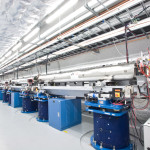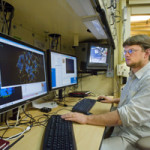During standard X-ray solution scattering experiments, molecules scatter X-rays as they tumble around during exposures, resulting in a diffraction pattern with matching measurements along all angles due to the full orientational averaging. When X-ray snapshots are collected at timescales shorter than a few nanoseconds, such that molecules are virtually frozen in space and time during the scattering experiment, X-ray diffraction patterns are obtained that are no longer equal along all angles. These measurements are collected using a method called fluctuation X-ray scattering, typically performed on an X-ray free electron laser or on a ultra-bright synchrotron. This technique can provide fundamental understanding of biomacromolecular structure, engineered nanoparticles, or energy-related intermediate-scale materials not attainable via standard scattering methods.
Second ALS Beamline Hits the 1,000 Mark
Peter Zwart’s group at the Advanced Light Source (ALS), Beamline 5.0.2, a protein crystallography beamline that is part of the Berkeley Center for Structural Biology (BCSB), became the second ALS beamline to reach the 1,000 published structures mark.
Was this page useful?
Send





